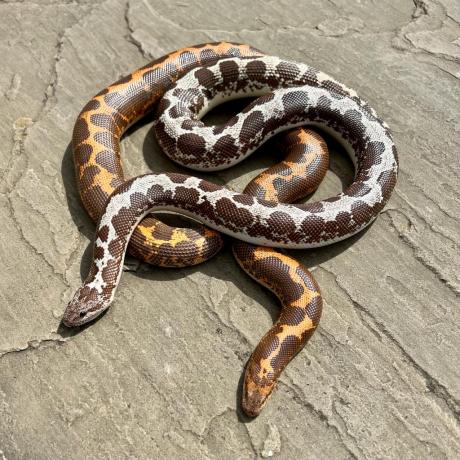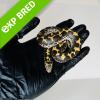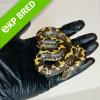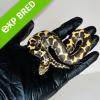

Kenyan Sand Boas are found living within sandy areas of East Africa. Adults vary greatly in size depending on sex. Males are small averaging 15 to 18 inches, whereas females are slightly larger and stocky growing to an average size of 30 inches.





Kenyan Sand Boas are arguably one of the most popular dwarf species of Boas. Females of this species are small, growing to no more than 3 feet (90cm) but males are even smaller! They usually reach no more than 2ft (60cm). Their wild type colouring is a base colour of creamy yellow or orange, with erratic splotches of dark brown, and a white belly. They have rounded, small heads with small eyes and vertical pupils, making them almost cartoon-like in appearance. They are available in a variety of colours including albino, anerythristic, snow, hypo and many more.
These small boas have a somewhat shy nature but are calm and can be handled easily. They are a great snake for any experience level.
In the wild, they are endemic to Northern and Eastern Africa. Found from Egypt to Nigeria, Somalia, Sudan, Kenya and Northern Tanzania.
They prefer habitats with sandy, loose soil such as semi-desert and scrubland savannahs with rocky outcrops. They will hide amongst stones and utilise small animal burrows to avoid the scorching heat during the daytime.
As long as their environmental requirements are met, Kenyan Sand Boas are a straightforward snake to keep.
Young Kenyan Sand Boas can be housed in smaller enclosures 24x15” (LxW), but sub and fully-grown adults thrive in a 36x18x18” (minimum) vivarium. They may be a fairly small species, but with all reptiles it is important to provide them with the necessary space to display natural behaviours for both their physical and mental wellbeing.
You will need to provide your Sand Boas with a basking temperature of 32-35C (90-95F) during the day with a drop down to 25C (75F) at night. You can maintain the temperatures by using either a basking lamp with a guard or a heat mat for hatchling enclosures, and as always, a thermostat should control all heat sources to avoid risk of overheating and ensure the correct temperatures are maintained. In the wild this species burrows away from heat, so provision of a deep sand/soil mix substrate, with a scattering of suitable flat rocks and cork will help the boa thermoregulate effectively.
We also advise the use of low level UVB lighting for your Sand Boas, research shows that UVB exposure contributes to healthy animals, both mentally and physically. Many snakes, including nocturnal species will ‘cryptically bask’ by leaving a part of their body exposed to the sunlight when hiding. The lighting is recommended to be on for 12 hours during the day and switched off at night to allow for a natural night time light and temperature drop.
They require moderate/low humidity levels, and if kept too dry over long periods, this can cause problems shedding their skin. In their wild habitat, they burrow down to a level where temperatures are lower and humidity levels are slightly higher than the surface. Naturally this makes achieving this in a captive environment a little more tricky. Though this species will live quite happily in the lower end of the humidity range, the addition of a humidity box filled with damp sand mixed with a little moss can also be useful to aid the shedding cycle. This can be sunk into the substrate with the access hole in the top, simulating a burrow for them to use. Fresh water should be provided daily in a dish/bowl so your snake may drink or bathe. With desert species, we like to download a weather app and monitor their region. This can help you understand the range of weather conditions they would experience in the wild.
Kenyan Sand Boas though often provided with fairly basic enclosures, lack of space and mental stimulation caused by this environment can potentially have long term implications to the snake. They do prefer a more ‘cluttered’ enclosure, with the addition of multiple rocks, hides, cork bark, and plants all at different levels provides enrichment and helps the animal feel safe. Often they sit with just their nose out of the substrate so are hiding in plain sight.
Feed your Sand Boas on defrosted mice. The size of food given depends on the size of the snake, this shouldn’t be any larger than the widest part of the animals body. Young Kenyan Sand Boas should be fed every 7-10 days, older Kenyan Sand Boas every 10-14 days and adults should be fed every 3 weeks with breeding females being fed every 2 weeks. It is best to make a log of when your snake eats and sheds its skin, this helps to spot any patterns or behaviours linked to the feeding cycle.